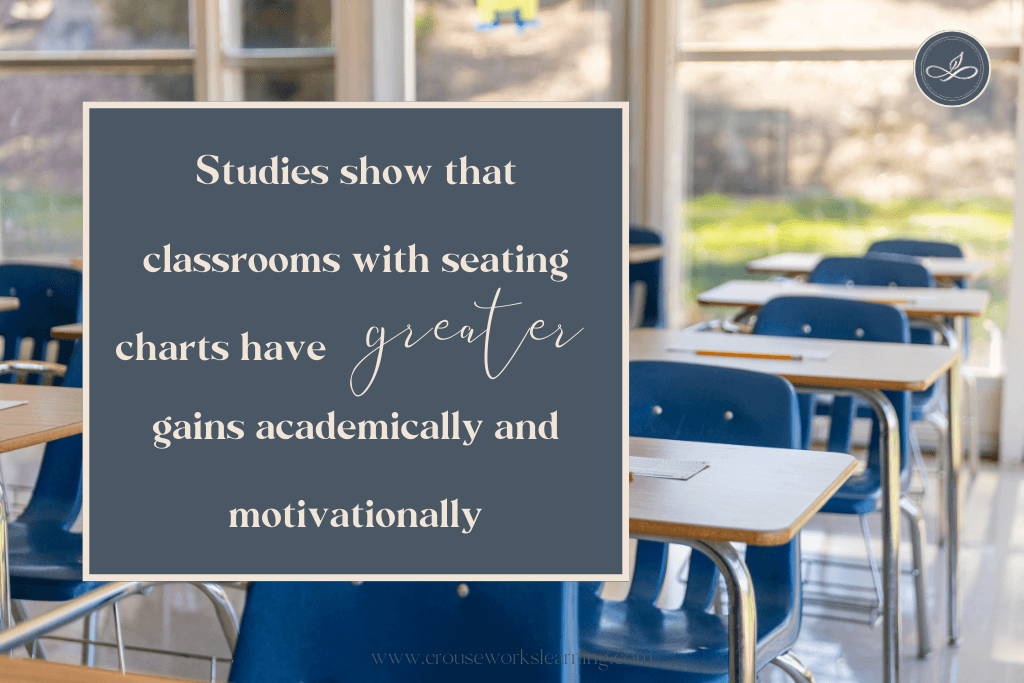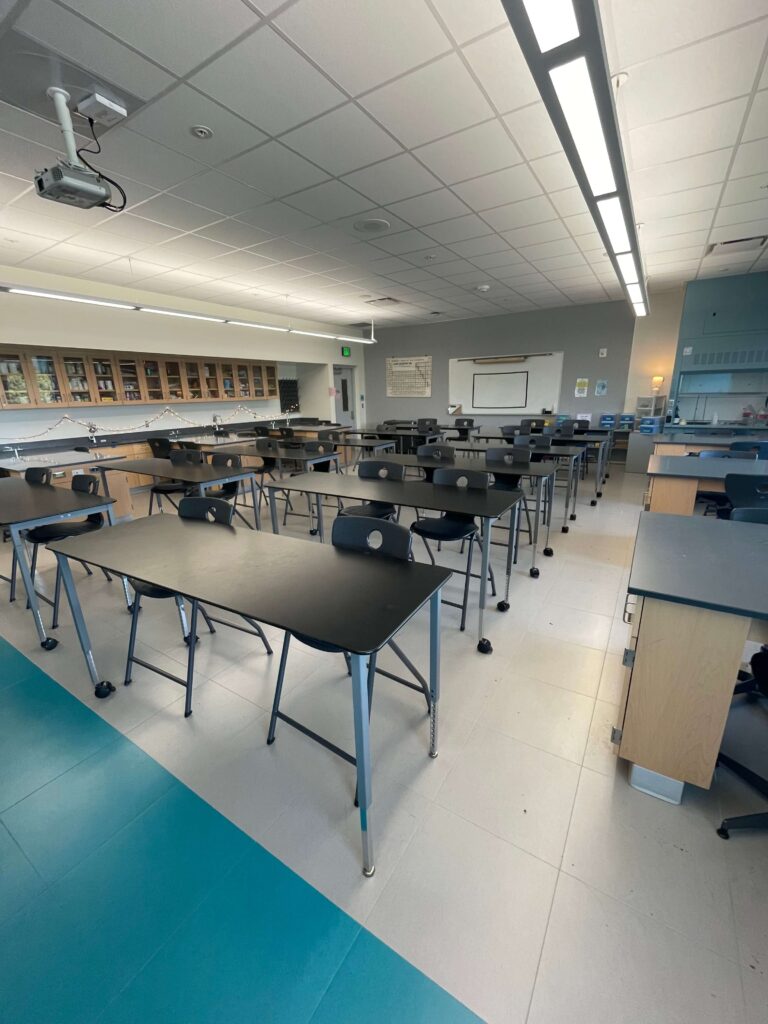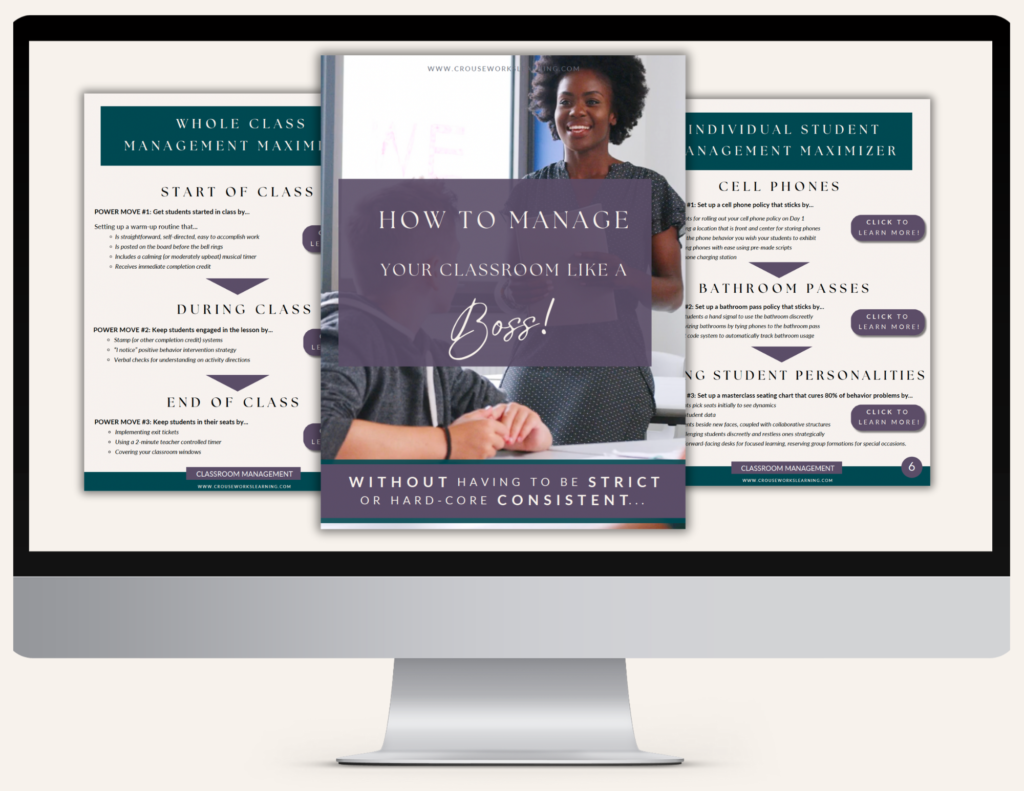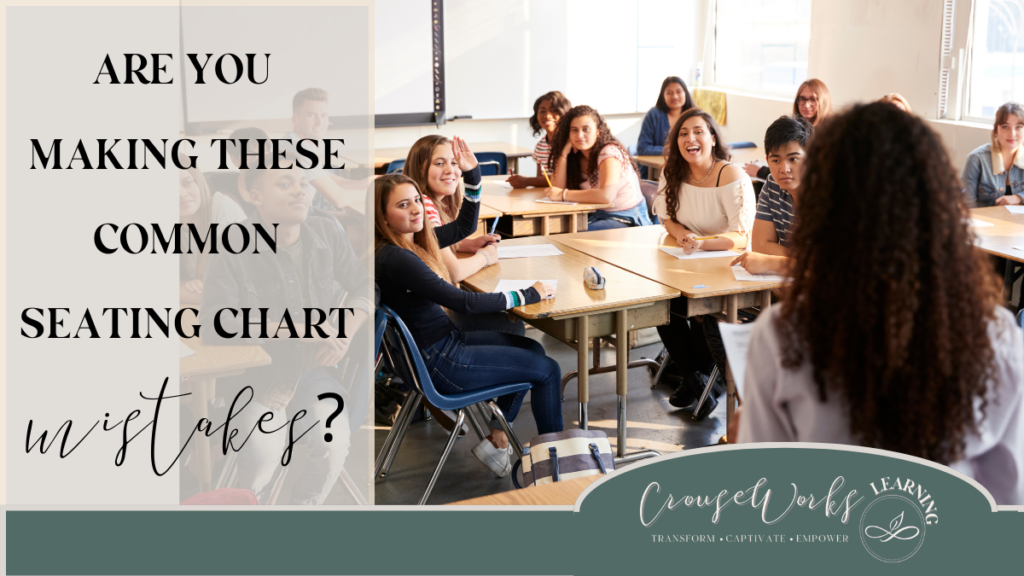Do you ever dream of a teaching hack that can miraculously solve 80% of your classroom behavior challenges? Well, hold onto your lesson plans, teacher friends, because I’m about to introduce you to the most humble, unassuming, yet oh-so-enchanting teaching trick yet… the magical world of seating charts!
If you’re a high school teacher on a mission to create a supportive and thriving classroom environment, seating charts are your golden ticket. And let me show you how.
Let’s dive into why seating charts are the secret weapon to behavior management you’ve been waiting for, and I promise, by the end of this post, you’ll be ready to orchestrate your classroom seating arrangement like a maestro!

SECTION #1: I’m nervous about using a seating chart in high school. Aren’t the kids too old for that? Won’t they hate me for it?
Picture this: a class where behavior problems are thwarted before they even rear their heads. That’s the magic of seating charts. These organized arrangements are not just about physical positions; they’re proactive classroom management tools that put the kibosh on disruptions!
Plus, did you know studies reveal that students in seating-chart-arranged classrooms have more significant gains academically and motivationally? Why is that, you ask? Well, think of seating charts like a big, warm hug for your English language learners and students with special needs. Seating charts provide customized support for students, as well as promote inclusivity, and aid in behavior management. That’s a win-win-win in my book!
Additionally, you should know that seating charts are super normalized in schools. Don’t feel bad about creating a seating chart. And don’t worry about high school students thinking your seating charts are too elementary for them. I guarantee your students (even your 12th graders) have several or more teachers who require seating charts.
Now, will students likely grumble the first day you bust the seating chart out? Sure, most definitely. But kids will quickly move on and will have forgotten about it by the next day. The short-term memory of high schoolers is fantastic like that. And if a student continues to complain about their seat, for non-legitimate reasons (like they just want to sit closer to friends), then just “de-signify” it. Use my simple go-to line, “It’s good for you. You’ll see. ” Then walk away and smoothly move on with your lesson

SECTION #2: But if I create a seating chart, won’t kids stop talking altogether?
I understand your concern, teacher friend. I don’t know what’s worse- a class where every student is chatting away incessantly or a class where you can hear crickets? Both are incredibly uncomfortable. So, I get it. It’s a reasonable concern. But also… (if I may be so bold to say) not one you should worry too much about.
It took me a long time to trust that students would talk to whoever was around them- even if I placed them next to complete strangers! But ultimately over time students will get to know the students around them- no matter who they sit by. Just give it time; you’ll see. The initial hush after a seating chart is as temporary as snow in May. In fact, collaboration will surge back so quickly that you’ll likely miss that sweet sliver of silence you just had.
And if you’re still craving to speed up this connection process, just include suitable collaborative structures in your lesson, and you’ll be good to go (click here for more info).
SECTION #3: Whenever I sit down to create a seating chart, it takes me forever!
Don’t feel bad. A good seating chart takes a lot of time to put together! It can feel like a game of Tetris- but with emotions. It would be fantastic if some algorithm or app out there could magically put one together for you. But alas, there is not…
Seating charts will always be challenging because you are trying to create a chart that leads to the least behavior issues while also maximizing motivation, academic success, and student comfortability. And that’s a tall order! You’re not crazy- putting together a seating chart is no small feat! However, teacher friend, I PROMISE it is worth it!
SECTION #4: So, what are the ultimate battle-tested strategies for arranging seating charts these days?
OooOooo… now we’re getting to the fun stuff! Let’s make a game plan!
So, I always like to kick off my school year with two high-impact teacher moves before I sit down to create my seating charts.
- The first teacher task is simple. I let students sit where they want for the first few school days. Just trust me on this. The insights you’ll gain when you do this are pure gold and far outweigh any short-term feelings of discomfort or lack of control. When you let students sit where they want, you will quickly discover who their friends are, their level of extroversion or introversion around others, and their desire to hide in a classroom setting or be center stage. I then use this knowledge to create an effective seating chart on day 3 or 4 of the school year. I must admit. I do have a lot of fun with it. Students get pretty comfortable those first few days of school and never see that seating chart coming. It’s always in their best interests, though… and they’ll thank me later… maybe…

- The second teacher task takes a bit more work. At the beginning of the school year, I will go onto my district’s platform, extract the following details about students, and add them to a spreadsheet.
- Student ID #
- Student Name
- Grade Level
- Parent contact info (email and/or phone)
- Special needs accommodations
- 504 accommodations
- English language learner status
- Gifted and talented status
- Most recent attendance data
- Most recent math proficiency test score
- Most recent language proficiency test score
- On track to graduate status
I will say that while this data tracker does take a lot of work to put together, it is immensely beneficial for creating seating charts that maximize student academic gains. Not to mention, it also becomes an essential tool for staying on top of my SPED and ELD students’ accommodations!
Check out an example of my data tracker below!
SECTION #5: What if it’s mid-year, and I’m reading this article? What other strategies do you have for me?
Are you a mid-year teacher and wondering if seating charts still hold power? My answer? Absolutely! Seating charts aren’t just for fresh starts.
By mid-year, you know which students are your toughest cookies in class. You know the ones- the students who will never put their cell phones away, will never stop listening to music, and will quickly escalate when their behavior is scrutinized. As teachers, we all have those select students that we must compromise with repeatedly, and it will never be a delineated win. And truthfully, as soon as we accept that fact as teachers, the easier our lives will become.
Instead of fighting an uphill battle with those students, place those tough cookies near the sides of the classroom. That way, they are still engaged in the lesson, close to the board (albeit to the side), and won’t draw too much attention to themselves.
With these students, I often have a ‘don’t ask, don’t tell’ policy, which means as long as I don’t see or hear their cell phones or earbuds, I pretend they don’t exist. And as long as they are sitting off to the side (and therefore, don’t create a waterfall cascade of other students noticing and wanting to join in on their cell phone or earbud usage!) I’m good.
So, take a moment and think. Are there any students that particularly stress you out at this moment? Are there any students you need to let go of the need for “absolute behavior control” over and just let things be a compromise?
If so, what would happen if you tried placing those students on the side of the classroom? And allowed them to have their own little world (still within earshot of you) that also didn’t disrupt the learning of other students?
Just food for thought!
Section 6: What about students who can’t sit still and don’t seem to fit in the “mold” of seating charts?
Do you have students that have a hard time sitting still? Students that ALWAYS need to get up and get a tissue, throw something away, or open the door for the person knocking?
Then, believe it or not, a seating chart should be your first go-to behavior management strategy- not your last!
Place those sweet students NEAR the trashcan or tissue box or classroom door so they have the shortest walking distance possible (and won’t disrupt other students’ learning).
In fact, with my particularly “wiggly” high school students, I deliberately place them by the door so I can easily let them step out into the hallway without attracting the attention of other students. Remember, it’s about finding harmony. Students will always have eccentricities and quirks that may or may not disrupt the learning of other students. And it’s about capitalizing on students’ strengths and allowing those other “distracting” quirks to discreetly run their course in the most innocuous way possible.

SECTION #7: Okay, so you’ve talked a lot about student placement within seating charts… but what about desk arrangements?
Ahhh… great question. And one, I will answer as simply as possible because this post is getting long now! Can you tell I’m a tad obsessed with seating charts?!
My general rule of thumb for seating arrangements…. in any class and with any grade level, you will curb 80% of behavior problems if you have students facing forward in individual desks rather than facing each other in grouped formations.
Now, I know what you’re thinking. You’re thinking, “But Claire, I’m a science teacher, and I need my students to collaborate and conduct labs together!” And absolutely, I agree with you. In fact, in my class, we do a TON of collaboration work. So, on those days, I simply ask students to push their desks together to form group formations. Then, after the lab, the students go back to facing forward.
Why do I do this? Well, because no matter how you set things up, students who face each other are much more tempted to talk (and ultimately pay less attention to the front of the class).
So save your group formations for special occasions like activities and lab days, and for the rest of the time, let students face forward so they focus better. Not to mention, students can always collaborate with their next-door seat partners as needed!


Forward-facing desks
Group Formations
- For focused learning
- My class is structured like this 70% of the time
- P.S. Students can still turn to their seat partner for collaborative purposes!
- Reserved for special occasions (labs, activities)
- My class is structured like this 30% of class time
SECTION #8: Can you write out those steps for me one more time but in a more concise and digestible manner?
Yes, I can! So glad you asked
Ready to weave some magic into your classroom? Let seating charts be your wand! They transform behavior, nurture academic growth, and create connections where you least expect them.
Just follow these basic principles and you will be well on your way to a successful classroom!
- At the start of the year, let students pick seats initially to understand their dynamics.
- Leverage student data to tailor your chart for behavior, academics, and motivation.
- Seat students beside new faces, coupled with collaborative structures when possible.
- Place challenging students discreetly and restless ones strategically.
- Embrace forward-facing desks for focused learning, reserving group formations for special occasions.
I hope these tips prove useful for you, and happy charting, teachers!

P.S. If you thought these seating chart strategies were helpful, wait until you get ahold of my FREE “How to Manage Your Classroom Like a Boss” guidebook!
It’s chock-full of my BEST-KEPT classroom management hacks and teaching secrets…
Download the FREE guidebook now and watch your classroom dynamics transform on a dime!


